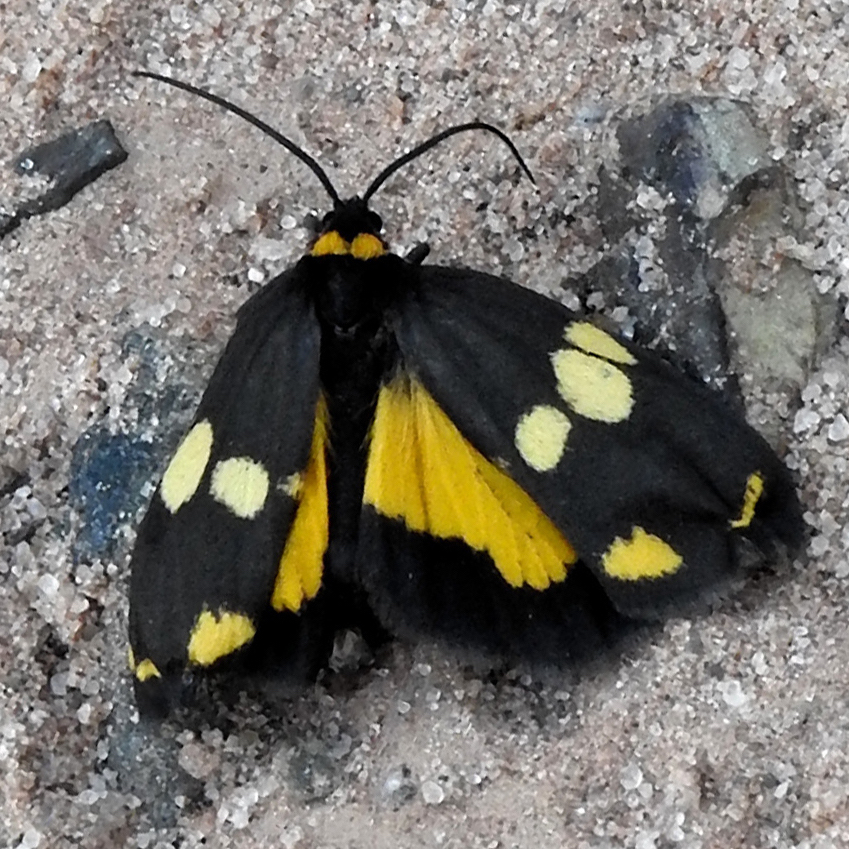Rediscovering an Overlooked Lichen Moth in Colombia and Venezuela
Resumen (español): El género Eudesmia incluye alrededor de 14 a 18 especies similares y se distribuye desde el suroeste de los Estados Unidos hasta el sur de América del Sur. Eudesmia lunaris es una especie distintiva que se encuentra en Colombia y Venezuela. Único dentro del género, es reconocible por las estrechas rayas anaranjadas cerca de la base de las alas anteriores, en combinación con los estrechos bordes anaranjados de la base de las alas anteriores y una mancha oscura en el tórax. Encontré alrededor de 38 observaciones de esta especie previamente no reconocida en iNaturalista.
Lichen moths of the genus Eudesmia Hübner are easily recognizable with their black wings that are boldly banded with orange or yellow.



Eudesmia arida, Texas @gcwarbler | E. menea, Panama @josuergg | E. australis, Brazil @pajeu
About 14 to 18 species are known from the genus at present. The genus is distributed from the southwestern United States to southern South America. Although they are easily recognized as a group, several species are difficult to separate in the field. This is the result of several factors: (1) many species are, indeed, quite similar; (2) original descriptions are often very brief and scattered in early literature; (3) a lot of individual variation in patterns was not appreciated by early researchers, resulting in the unnecessary naming of "new" species; (4) there is no recent revision of the genus nor any handy modern field guide to aid identification of the moths in this genus.
I have been digging back into the literature and trying to sort out some of the Eudesmia species which seem to have been overlooked in modern times. For instance, among the 17 species listed in iNaturalist's taxonomy as of 1 November 2022, images of only seven species had been uploaded. As well, since many observers just choose the most numerous or most-identified species as a suggested identification, the proportion of misidentified images is high.
As I read back through the original literature, one species described from Colombia seemed to stand out in that it ought to be quite recognizable. "Cisthene" [= Eudesmia] lunaris was described by Francis Walker in 1865 from a male specimen in the British Museum. Among other details, he mentions that the species has "a pale luteous [yellow-orange] subcostal streak extending from the base [of the forewing]" and "a pale luteous streak extending along the interior border from the base to the first [orange] band." Those orange streaks in the basal area and on the inner margin of the forewings are not evident in any other species in the genus. Hampson (1900) and Draudt (1918) published rather smudgy illustrations of lunaris which may have done more to obfuscated its identity rather than to help identify the species.


So I began perusing observations of Eudesmia uploaded from Colombia and Venezuela and immediately found dozens of images which match Walker's description.



E. lunaris, Colombia @smejiadu | E. lunaris, Colombia @juan-sebastian-leon-lleras | E. lunaris, Venezuela @fherrerav
They were also easy to separate from other Eudesmia because, unlike most other Eudesmia moths in that region which have a solid orange thorax, the newly separated Eudesmia lunaris more often than not have a small to large black spot in the center of the thorax and often small black dots at the front end of the tegulae (small tracts of scales flanking the thorax).
As of this evening (11/18/2022), I have put the name Eudesmia lunaris on about 38 iNat observations. The species appears to range from southwestern Colombia northeast to northern Venezuela near Caracas. Observations have been made in the lowlands, intermontane valleys, and lower Andean foothills up to 1,500 m elevations (mostly below 500 m). @gregory_nielsen uploaded the earliest image of Eudesmia lunaris on iNat, near Villavicencio, Colombia, and remarkably also documented the larva and pupa, almost certainly the first ever images of those.

Eudesmia lunaris larva, pupa, and adult; near Villavicencio, Meta Dept., Colombia @gregory_nielsen
One remaining conundrum was the identity of "Cisthene curvifera", described by Walker in 1865 on the same page as his Cisthene [= Eudesmia] lunaris. I noticed that the description of curvifera was very similar to that of lunaris, and that it had been described from a single female specimen from the same location (Bogota) and same collection ("Mr. Stevens") as lunaris. Curvifera seems not to have been illustrated anywhere and is not mentioned by any subsequent authors except in a list by Butler (1877). It seems pretty apparent that curvifera simply represents the female of Walker's lunaris; no one else seems to have bothered to point this out. I have a manuscript in preparation on the genus Eudesmia which will formally suggest that synonymy.
My thanks to the many iNaturalists who have uploaded their images of this and related species, and to @pfau_tarleton for coaching me on some of the formatting in this post!












